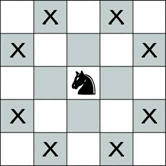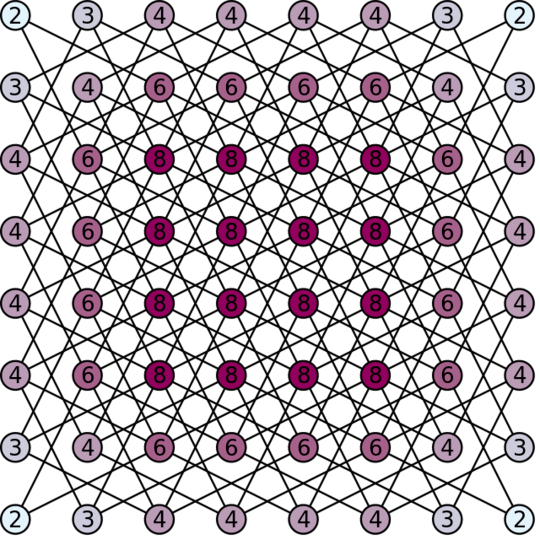20
2
In chess, a knight can only move to the positions marked with X relative to its current position, marked with ♞:
A Knight's Graph is a graph that represents all legal moves of the knight chess piece on a chessboard. Each vertex of this graph represents a square of the chessboard, and each edge connects two squares that are a knight's move apart from each other.
The graph looks like this for a standard 8-by-8 board.
Challenge:
Given an integer N, where 3 ≤ N ≤ 8, output an N-by-N matrix representing a board, where the number of possible moves from each position is shown. For N = 8, the output will be a matrix showing the values of each vertex in the graph above.
The output format is flexible. List of lists or even a flattened list etc. are accepted formats.
Complete set of test cases:
--- N = 3 ---
2 2 2
2 0 2
2 2 2
--- N = 4 ---
2 3 3 2
3 4 4 3
3 4 4 3
2 3 3 2
--- N = 5 ---
2 3 4 3 2
3 4 6 4 3
4 6 8 6 4
3 4 6 4 3
2 3 4 3 2
--- N = 6 ---
2 3 4 4 3 2
3 4 6 6 4 3
4 6 8 8 6 4
4 6 8 8 6 4
3 4 6 6 4 3
2 3 4 4 3 2
--- N = 7 ---
2 3 4 4 4 3 2
3 4 6 6 6 4 3
4 6 8 8 8 6 4
4 6 8 8 8 6 4
4 6 8 8 8 6 4
3 4 6 6 6 4 3
2 3 4 4 4 3 2
--- N = 8 ---
2 3 4 4 4 4 3 2
3 4 6 6 6 6 4 3
4 6 8 8 8 8 6 4
4 6 8 8 8 8 6 4
4 6 8 8 8 8 6 4
4 6 8 8 8 8 6 4
3 4 6 6 6 6 4 3
2 3 4 4 4 4 3 2
This is code-golf so the shortest solution in each language wins. Explanations are encouraged!


1Related challenge to query the number of knight moves from a square on an 8*8 board. – xnor – 2018-08-11T16:16:16.557
Can the output be a flat list of n*n elements? – xnor – 2018-08-11T16:29:14.667
13This is literally just edge-cases! :) – Jonathan Allan – 2018-08-11T17:58:41.937